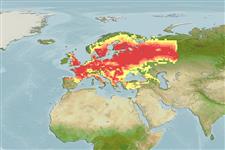Classification / Names
Common names from other countries
Issue
Alburnus maximus (Fatio, 1882) is a valid species according to Buj et al. (2010: Ref. 85064), and Freyhof, pers. comm. (13 Dec. 2010). The corresponding species summary page will be created in the future.
Main reference
Size / Weight / Age
Max length : 25.0 cm TL male/unsexed; (Ref. 30578); common length : 15.0 cm TL male/unsexed; (Ref. 30578); max. published weight: 60.00 g (Ref. 30578)
Length at first maturity
Lm 9.9, range 9 - ? cm
Environment
Freshwater; brackish; benthopelagic; pH range: 7.0 - ? ; dH range: 10 - ?; potamodromous (Ref. 51243); depth range 1 - ? m (Ref. 30578)
Climate / Range
Temperate; 10°C - 20°C (Ref. 2059), preferred ?; 68°N - 35°N, 6°W - 60°E
Distribution
Europe and Asia: most of Europe north of Caucasus, Pyrénées and Alps, eastward to Ural and Emba. Naturally absent from Iberian Peninsula, Adriatic and Aegean basins (except Maritza drainage), Italy, Ireland, Great Britain (except southeast), Norway and Scandinavia north of 67°N, Caspian basin south of Volga. In Anatolia, Marmara basin. Locally introduced in Spain, Portugal and Italy. At least one country reports adverse ecological impact after introduction.
Countries | FAO areas | Ecosystems | Occurrences | Introductions
Short description
Dorsal
spines
(total): 2 - 4;
Dorsal
soft rays
(total): 7-9;
Anal
spines: 3;
Anal
soft rays: 14 - 20;
Vertebrae: 41 - 44. Diagnosed from congeners in Europe by the possession of the following characters: origin of anal fin below branched dorsal rays 4-5; lateral line with 45-48 + 3 scales; anal fin with 17-20½ branched rays; 16-22 gill rakers; ventral keel exposed from anus to pelvic base; lateral stripe absent in life, faint or absent in preserved specimens; and mouth slightly superior (Ref. 59043). Caudal fin with 19 rays (Ref. 2196). Also Ref. 40476.
IUCN Red List Status (Ref. 115185)
Human uses
Fisheries: minor commercial; aquaculture: commercial; bait: usually
Tools
Special reports
Download XML
Internet sources
Estimates of some properties based on models
Phylogenetic diversity index
PD50 = 0.5000 many relatives (e.g. carps) 0.5 - 2.0 few relatives (e.g. lungfishes)
Trophic Level
2.7 ±0.29 se; Based on food items.
Resilience
Medium, minimum population doubling time 1.4 - 4.4 years (tm=2-3; K=0.19; tmax=7; Fec=1,500)
Vulnerability
Low to moderate vulnerability (31 of 100)
Price category
